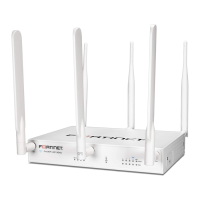Connection troubleshooting
Device registration
For certain carriers like Verizon, the FortiGate device serial number needs to be registered with the network provider to
be recognized. Make sure that your device is registered with the carrier.
LTE network registration
The most straightforward way to check LTE network connection status is to view some of the LTE connection protocol
status of the modem. The following snapshot of “diagnose test application lted 5” is taken from a
connected unit:
EMM state: Registered Normal Service
RRC state: RRC Connected
IMS reg state: No Srv
These parameters show the current modem registration status with the LTE network. The following figure illustrates
EMM, ECM and RRC states associated with the UE and MME. EMM can be in either “EMM-Registered” or “EMM-
Deregistered” state depending on whether the UE is attached to, or de-tached from, the network. ECM can have either
“ECM-Connected” or “ECM-Idle” depending on whether a NAS signaling connection (i.e., ECM connection) is
established or not. Likewise, RRC can be in either “RRC-Connected” or “RRC-Idle” depending on whether an RRC
connection is established or not. The following diagram shows the conditions in which a UE stays in a particular state.
IMS state is for voice-over-IP service which may not be of interest to us.
The following table describes the meaning of each parameter.
Layer State Entity Description
EMM EMM-registered UE, MME UE has been attached to the LTE network and an IP has
been assigned to the UE. An EPS bearer has been
established. MME knows the current location of the UE
with the accuracy of a cell.
EEM- UE is not attached to any LTE network. MME does know
FortiGate-FortiWiFi 5.0 3G4G LTE Modem Operator's Manual 63
Fortinet Technologies Inc.

